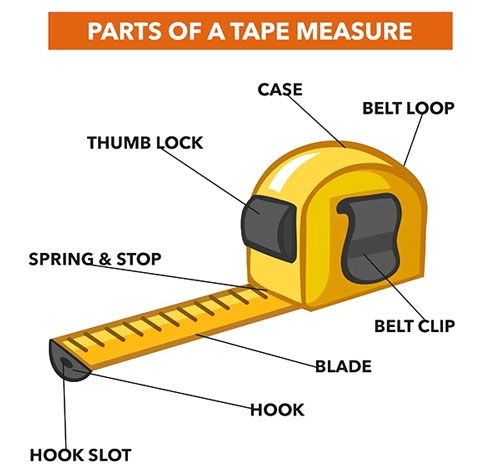A measuring tape is a common measuring tool primarily used to measure the dimensions of objects, including length, width, and depth. Widely employed in various fields such as engineering, construction, and home improvement, the measuring tape is essential for diverse measurement tasks. In this article, sisco will explore the usage and readings of the measuring tape to assist readers in employing it correctly and accurately for measurements.
Basic Structure of Measuring Tape
A measuring tape consists mainly of two parts: the tape measure case and the tape measure blade. The case, typically made of plastic or metal, serves as housing for the measuring tape blade. The measuring tape blade is a flexible strip, usually made of metal, with markings or graduations.
Both ends of the measuring tape blade are usually equipped with movable metal hooks used to secure the tape to the endpoints of the object being measured. One hook is fixed, and the other is movable. As the measuring tape is extended, the movable hook moves along, allowing for the measurement of the object's dimensions.
Usage of the Measuring Tape
To use the measuring tape correctly for measurement, follow these steps:
- Open the measuring tape case and extend the measuring tape blade to the desired measurement range.
- Place the fixed hook against one end of the object to be measured, ensuring it snugly contacts the object's surface.
- Pay attention to the markings on the measuring tape blade. Measuring tapes typically have two types of markings: centimeter and inch graduations. Choose the appropriate scale as needed.
- For measuring length, place the movable hook against the other end of the object, ensuring it tightly contacts the object's surface.
- Read the numerical value on the markings. The value on the markings represents the length of the object being measured. If using inches, be aware of the representation of inches and fractions, such as 1 inch being represented as 1" or 1/12".
- To measure width, use both sides of the measuring tape. Place one movable hook against one side of the object and the other movable hook against the opposite side, then read the numerical value on the markings. Note that measuring width requires attention to the perpendicular alignment of the measuring tape blade with the object.
- For measuring depth, use the end of the measuring tape blade. Place the end against one edge of the object, insert the measuring tape blade along the object's surface until reaching the desired depth, and read the numerical value on the markings.
- After completing the measurement, retract the measuring tape blade into the case and close the measuring tape case.
Reading Measurements from the Measuring Tape
When reading measurements from the measuring tape, consider the following points:
- Accuracy: The accuracy of the measuring tape is typically represented by the smallest unit of the markings. Generally, higher accuracy means smaller increments on the markings, allowing for more precise measurements. Choose the measuring tape accuracy based on specific requirements.
- Alignment of Markings: Ensure that the markings align with the edge of the object when reading numerical values. Deviations between the markings and the object's edge may result in measurement inaccuracies.
- Unit Selection: Choose the appropriate measurement unit based on your needs. Measuring tapes usually offer centimeter and inch units. Decide on the unit before measuring and convert readings correctly.
Using Tips for Measuring Tape

When using a measuring tape for measurements, you may encounter common issues and considerations:
- Tension in the Tape: Maintain an appropriate level of tension during the measurement process to ensure the measuring tape blade adheres closely to the object's surface. Excessive tension may lead to the measuring tape blade deformation, affecting measurement accuracy.
- Sources of Measurement Errors: Measurement errors in a measuring tape can arise from various factors, including stretching errors in the measuring tape blade, deviations in fixed and movable hooks, etc. For precise measurements, consider these factors and make necessary corrections.
- Relationship between Measurement Accuracy and Lifespan: Measuring tapes with extended usage may experience wear and tear, resulting in decreased measurement accuracy. For critical measurement tasks, use a new measuring tape or regularly calibrate an old one to ensure measurement accuracy.
The measuring tape is a common and practical measuring tool that, when used accurately and correctly, aids in achieving precise measurements for a variety of tasks. When using a measuring tape for measurements, readers should adhere to usage guidelines and considerations to ensure measurement accuracy. This article aims to provide assistance to readers in understanding the usage and readings of measuring tapes.

